
Pathologies of auditory canals can be many. Most of them lead to a decrease in the level of auditory perception, sometimes completely. Auditory perception largely depends on the patency of channels located in the depths of the ear organs. Sometimes this patency is disturbed by some obstacle, most often by water.
In this case, a medical procedure comes to the aid, like blowing the ears on Politzer. In the article we will tell about this manipulation: We will find out what it is, for which it is useful to blow the ears. We also learn how to manipulate correctly, and whether it is possible to do it at home.
Content
- 1 Indications
- 2 Preparation
- 3 Performing
- 4 procedures Contraindications
- 5 Complications
- 6 How to blow your ears at home
- 6.1 method Valsalva
- 6.2 method Toynbee
- 6.3 Metot Otoventa
- 7 Recommendations
Indications
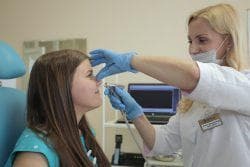
Appointment blowing by Politzer done ENT doctor on the basis of examination of the patientand the medical history of the latter. The technique is widely used for therapeutic and even diagnostic purposes. When otitis is one of the most common methods of removing serous fluid from the tympanic cavity. In what other cases, and with what pathologies can be purged blowing the ears of Politzer.
- Decreased auditory perception as a result of transferred otitis of different kinds. Blowing is prescribed and, if necessary, to remove the exudate accumulated in the inner ear after the otitis.
- If suspected of accumulation of exudate( organic fluid) in the auditory canals. In this case, blowing helps quickly to get rid of this obstacle.
- After the disease of the nasopharynx of acute and chronic course, it is sometimes necessary to resort to blowing along the Politzer.
- If there is a suspicion that the tympanic membrane is deformed or perforated.
- When, so-called, aerotote, when there is a sense of congestion as a result of sudden pressure drops( when the aircraft is down, diving, fast driving, etc.).
- If the Eustachian tube has an obstruction, the blowing will only give a short-term effect. But in this case, the benefit of the procedure will be, since the airflow normalizes the position in the auditory organs of the tympanic membrane. This fact positively affects the work of the entire hearing aid.
Polytzer blowing can also be prescribed if the patient complains about:
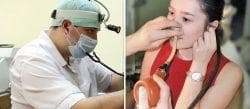
- poor audibility of sounds;
- noise and rustling in the ears( most likely, it's water);
- stuffiness of the ears;
- headache( but only if there are previous symptoms);
- pain in the ears.
The need to restore the patency of the Eustachian tube is also one of the main indications for the procedure. Sometimes the procedure is assigned and purely for diagnosis. As a rule, in order to see how passive the Eustachian pipes are, and to assess whether they cope with ventilation and drainage of the auditory canals.
Warning: if you feel that your ears have been laid, and your own voice is heard from somewhere far away, you should immediately see an ENT specialist. The severity of the disease can be indicated by the heaviness in the head and pain. Special caution is caused by such symptoms, if they arose against the background of recent colds. This may well be a complication of the flu or sore throat.
Preparation of
Before proceeding directly to the purging process, the health worker will prepare the patient for the upcoming manipulation. What is done for this, we learn.
Cleaning of the nasal cavity is necessary, so that the air can go unhindered "on its way". For this, the accumulated mucus is removed from the nasal passages. Most often the patient is asked just how to blow his nose.
Mucous nasals are treated with vasoconstrictive solutions to eliminate the possibility of edema.
On video blowing the ears of the politician:
If the patient has a high pain threshold, then the treatment of the nasal mucosa with mild analgesics is allowed for a more comfortable blowing.
Executing the procedure
Let us find out how this procedure is performed in the conditions of the medical room.
The instrument itself, which is manipulated, is a rubber pear with a long hollow hose( the instrument of the Politzer), on which the tips of different sizes are attached. These tips are selected by a specialist individually in each specific case: the child has one width of the nostril, the adult male has a completely different one.
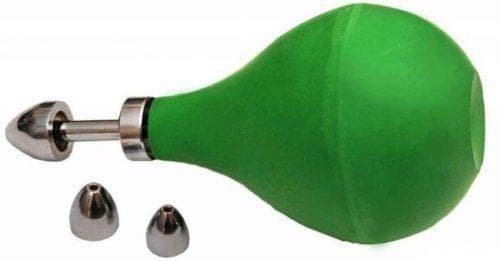
The
Polisher Device The procedure is as follows:
- The pear tip with the selected size of the nozzle is inserted into the nostril of the patient. The doctor clamps the nostril, securely fixing the hose nozzle in it. The doctor keeps the pear with the other hand.
- The patient is asked to say some words with rhythmic syllables( for example: pa-ro-stroke), and on one of the vowel sounds, getting to the rhythm of his pronunciation, the doctor presses sharply on the pear.
- Air enters the nostril, then into the ear tube, thence into the drum cavity. Strong and active air pressure "disperses" obstacles that interfere with normal auditory perception: water, sulfur and so on.
- The patient's head is tilted so that serous fluid or exudate can flow freely out of the tympanic cavity through the nose and mouth.
Sometimes just two or three procedures are enough to return a lost hearing to the patient and relieve him of unpleasant sensations. But in cases of severe otitis media, it is necessary to purge sometimes for weeks.
Blown by courses: from five to ten sessions per course. This procedure is used as an integral part of complex treatment: along with blasting, it is necessary to take medications, physiotherapy procedures. If blowing does not give results, the doctor decides to stop these manipulations, and to appoint more radical methods of treatment: for example, catheterization.
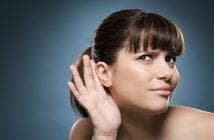 For those who want to learn more about how long the tympanum heals after the break, it is worthwhile to follow the link and read the content of the article.
For those who want to learn more about how long the tympanum heals after the break, it is worthwhile to follow the link and read the content of the article.
And here's how the treatment of tubo-otitis in children is going to help understand this information.
how to cure the problem, when the ear was pawned with a cold and what means are the most effective.will help to understand this article: http: //prolor.ru/u/ lechenie-u / zalozheny-ushi-pri-prostude-chto-delto.html
But whether to use the onion in your ears for a cold and how, this article will help you understand.
Contraindications
In which cases, blowing the ears on the Politzer is prohibited.
In acute infectious and inflammatory processes in the nasopharynx, auditory canals. Any infection of the viral and bacterial nature is an obstacle to the procedure. 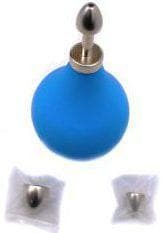
In case the patient suffers from mental or neurological disorders. In this case, the procedure itself is questionable. The fact is that this procedure with unaccustomed use can even frighten, so the behavior of a person with a mental deflection can be unpredictable. To exclude the risk of an attack of rage, aggression, and similar manifestations, purging by such a patient is not carried out at all.
Runny nose is a contraindication for purging. A strong stream of air can drive slime from microbes into internal auditory passages, which will lead to serious complications, possibly to purulent otitis.
Complications of

If the procedure was performed with non-compliance with safety regulations, carelessly, carelessly, or in general at home, its following complications are possible:
- The rupture( perforation) of the tympanic membrane. And if it did not come to a break, then deformation is possible.
- Sometimes poorly executed purging causes purulent otitis media.
- Nasal bleeding. Usually this happens if the blood vessels are weak, or the health worker has not calculated the strength and sharpness of the pressure.
- If the patient is diagnosed with epilepsy or Parkinson's disease, then sudden, and for the first time - unexpected, pressing the doctor on the pear can cause seizures, cramps, even loss of consciousness.
- Such a serious illness, like the emphysema of fiber, can also be the result of blowing. Emphysema means that the air got under the skin, causing the strongest swelling of the tissues.
- Incorrectly performed self-purging can lead to even such a terrible disease as meningitis. It is also possible sepsis - no less formidable trouble.
In addition to the above, patients often complain of tinnitus and dizziness during the procedure. But these phenomena pass almost immediately after the end of blowing.
How to blow the ears of the house
Using the method "for the Politzer" at home is extremely undesirable, as this leads to traumas of the auditory organs. But at home you can use other methods of blowing: more simple and sparing. What, we will consider.
Valsalva Method

To perform this procedure, you need to take a deep breath, cover your nostrils and try to breathe out through your nose, pushing the air with effort.
And since the nostrils are covered, the airflow goes into the auditory canal, blowing it.
It is not necessary to exhale sharply and strongly, so as not to injure the delicate organs of hearing.
Toynbi method
To perform the procedure, you need to close your nostrils with your fingers, take a sip of water in your mouth, and swallow it. So repeat until the feeling of stuffiness disappears.
Otodent's method
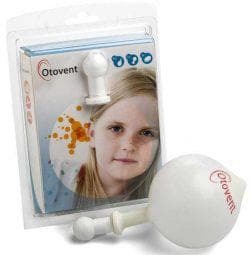
Simplified method "on the Politzer".To carry out this blowing, you need to purchase equipment "Otovent", which is a rubber hollow ball with a nozzle.
The nozzle is inserted into one nostril, the second one is clamped with a finger: you need to try to inflate the rubber ball with your nose. Both nostrils should be involved in turn. Sometimes a few nasal exhalations are enough to make the stuffiness of the ears be eliminated.
These methods are much safer than "on Politzer", therefore they are allowed for use at home. And the type of blowing discussed in the article should be left for execution by competent medical workers.
But what are the main reasons for that dizzy and lays ears, will help understand this information.
It will also be interesting to learn how to cure ear inflammation at home.
How inhalation is done with laryngitis and which medication is most effective for this is described in great detail in this article.
And here is it possible to make a compress of cottage cheese with a sore throat and how effective it will help to understand this information.
You may also be interested in knowing why the ear was stuffed during a cold.
Recommendations
We advise you not to be afraid of doing a blowdown. The first time a sharp passage of air through the nasopharynx and auditory strokes can cause not quite the usual sensations, even - unpleasant. But then, after getting used to it, the procedure is already transferred without any problems. In addition, the mucous is treated with an anesthetic solution, so the procedure does not cause pain. Children even like this procedure. If, of course, the child is already grown up, and not just a kid.
It is not recommended to conduct the procedure on its own, at home. For its proper implementation, a certain skill is required, and a knowledge of the structure of the auditory organs and the nasopharynx.
Other nuances are important, which are usually unknown to the average person. The result of inept attempts at blowing out can even be a rupture of the tympanic membrane, if not calculate the force of pressing the pear. It is also possible to put the infection in the ear canals.
We examined the peculiarities of blowing the ears of Politzer. As you can see, the procedure has undoubted benefits, and its analogs are also feasible at home. But before deciding on blowing, be sure to show the doctor to make sure that there are no contraindications to the procedure, and to establish the exact cause of hearing loss.
